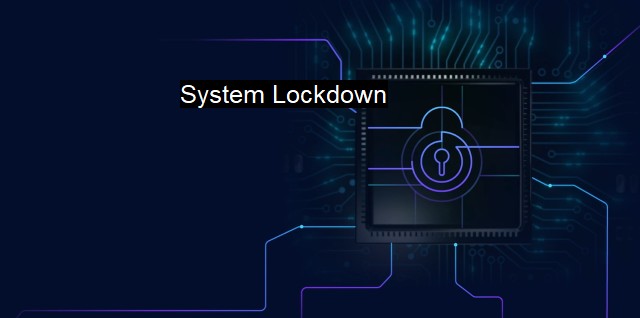What is System Lockdown?
The Importance of System Lockdown: Vital Steps to Protect Your Computer Systems and Networks from Cyberattacks
System lockdown in cybersecurity and antivirus contexts constitutes enforced limitations within a computer system or network that reactively or proactively reduces vulnerabilities to potential threats and attacks. This strategy revolves around the philosophy of restricting functionality and access in order to defend against malware, hackers, and other cyber-related threats.System lockdown primarily characterizes a multi-faceted measure to strategically narrow down the attack surface making systems less susceptible, thus preventing unauthorized access or disruption of computer systems. To ensure this hardened security state, specific functions, applications, and accessibility are limited to handle identified or potential threat exposures.
It is essentially an evolution of the "defense in depth" strategy used in various secure environments, where multiple security layers are implemented. Using this approach, even if one protection measure fails, the others remain operative, enhancing the chances of defending against a cyber attack. One of the issues of the commercial off-the-shelf software (COTS) and networks is their inherent complexity. While designed to bring maximum flexibility and functionality, this also introduces a host of potential vulnerabilities. A system lockdown strategy functions on the principle of blanket disability or removal of non-base functions, eliminating layers of potential weakness.
Comparatively, approaching such a heightened security measure begins with evaluating what is truly required from the system. Non-essential functionalities are then selectively pruned through various means such as turning off unneeded services, eliminating unused software, and closing unrequired network ports; effectively a move from greater complexity to abated simplicity for ensured network safety.
This threat-agnostic approach to security also introduces the concept of whitelisting. This operation only permits the running of predefined, safe applications while blocking everything else. Although quite draconian, it's highly effective. the implementation of this methodology requires meticulous planning due to its organizational impact and high management overhead.
System lockdown further involves strict control over levels of user access. Non-administrative users should only have limited permissions to ensure that they cannot unwittingly enable the downloading and installation of potentially malicious software. All core system files and important software components should be treated as read-only with write access granted to only a select few.
Most organizations implement system lockdown measures using the combination of security policies and technical controls. Security policies could include information classification, incident response handling, and disaster recovery planning. On the other hand, technical controls could range from antivirus software and intrusion detection systems to firewalls and encryption technologies.
Antivirus is a critical part of the system lockdown process. It checks for known malicious codes or behaviors associated with malware, such as viruses, worms, or ransomware. Modern antivirus solutions also employ real-time scanning, ensuring each file is scrutinized before being accessed or opened, effectively providing a proactive layer of defense.
System lockdown architecture is an effective strategy that pessimistically secures a system with the least privileged operation. It significantly minimizes the attack surface, making adequate provision against potential cyber threats. Although practically requiring excessive maintenance and expertise in planning and execution, this approach defines a more secure operation and proves beneficial to achieving security goals. An important tenet of modern cybersecurity, system lockdown combines both policy-based and technical aspects to promote best practices in preventing unauthorised access and potential system disruption.

System Lockdown FAQs
What is System Lockdown?
System Lockdown refers to the process of securing a computer or network from a potential cyber attack. This involves restricting access to certain applications, programs, and data, and implementing security measures such as firewalls, antivirus software, and intrusion detection systems.What are the benefits of System Lockdown?
System Lockdown provides several benefits in terms of cybersecurity. It helps prevent unauthorized access to sensitive data, restricts the execution of malicious software, and reduces the risk of cyber attacks. It also ensures compliance with regulatory standards and enhances the overall security posture of organizations.What are the best practices for System Lockdown?
To ensure effective System Lockdown, organizations should implement a comprehensive cybersecurity strategy that includes regular updates and patches for operating systems and applications, strong passwords and access controls, and continuous monitoring and testing of security systems. They should also conduct regular security awareness training for employees to help prevent social engineering attacks.How can antivirus software help with System Lockdown?
Antivirus software is an essential component of System Lockdown as it provides protection against malware, viruses, and other cyber threats. It can detect and remove malicious software from an infected computer, prevent the installation of new malware, and block unauthorized access to the network. It is important to keep antivirus software updated to ensure it can detect and protect against the latest threats.| | A | | | B | | | C | | | D | | | E | | | F | | | G | | | H | | | I | | | J | | | K | | | L | | | M | |
| | N | | | O | | | P | | | Q | | | R | | | S | | | T | | | U | | | V | | | W | | | X | | | Y | | | Z | |
| | 1 | | | 2 | | | 3 | | | 4 | | | 7 | | | 8 | | |||||||